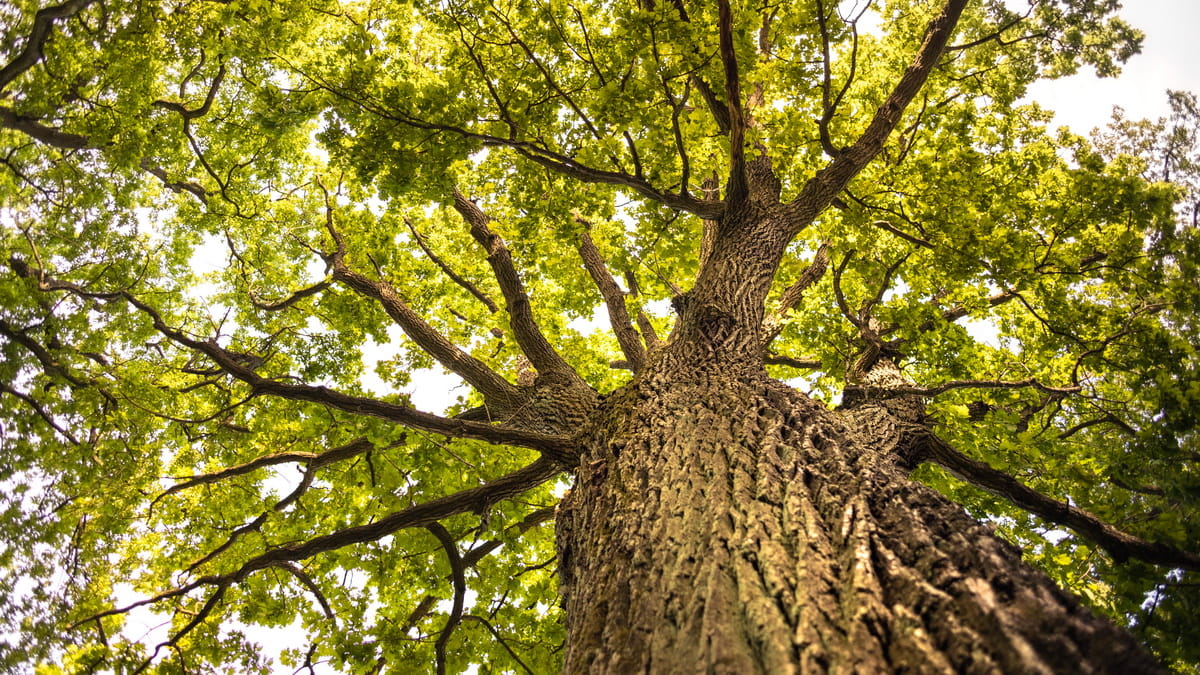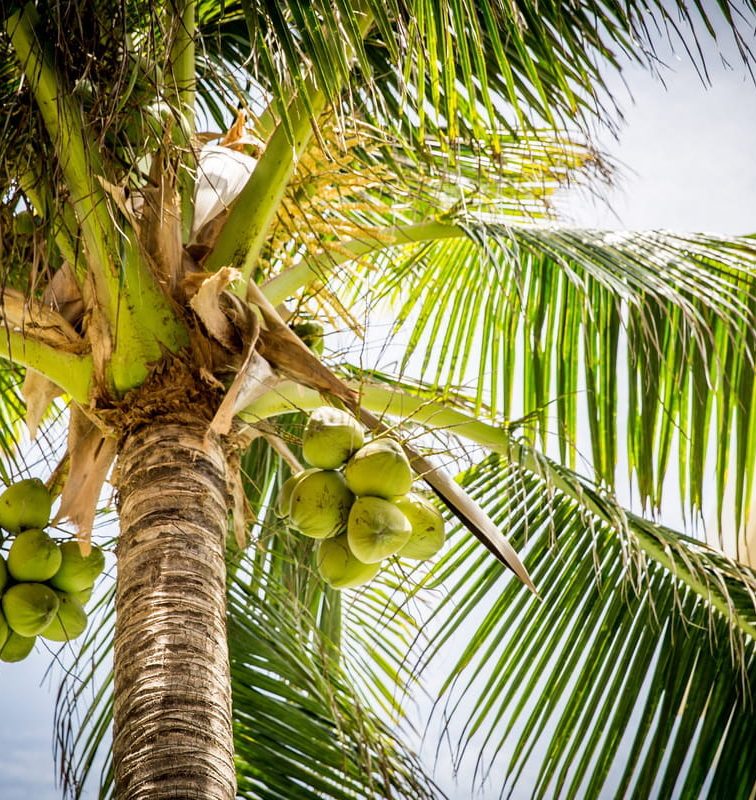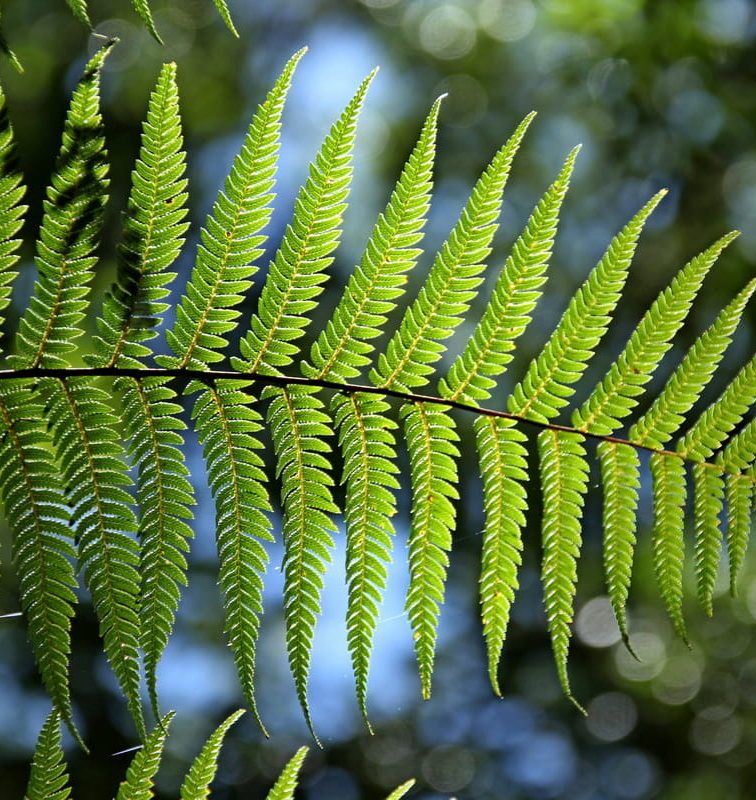Greetings, nature enthusiasts and knowledge seekers! 🌳 Did you know that some oak trees can live for over a thousand years? Or that certain oaks have been used as historic landmarks and meeting points throughout the ages? Oaks are not just massive plants; they’re storied monuments of nature with a vast array of tales to tell.
From the coastal breezes that sway the California live oak to the underwater marvels of the water oak, every oak has a story. And it’s not just about the birds and the bees; there’s history, science, and a touch of magic in these boughs.
Whether you’re a budding naturalist, a quiz master, or a curious soul eager to unravel the wonders of the oak universe (especially kids ready for a dash of enchantment), prepare to be enlightened. We’re about to embark on a journey into the very rings and roots of these regal giants. Dive in, and discover the rich legacy and fun facts of the majestic oak trees!
1. Oaks and Their Global Domination Tour
Have you ever thought about backpacking around the world? Oak trees, members of the Quercus genus, embarked on this adventure millions of years ago. Their footprints span both the eastern and western hemispheres. North America alone boasts over 90 species, while Asia houses around 150. Europe, though comparatively smaller, is rich with nearly 50 unique oak species.
Historically, the Celts revered oaks as symbols of strength, and in Greek mythology, they were sacred to Zeus. There’s even an oak in California, the Pechanga Great Oak, estimated to be over 1,000 years old. Such widespread and historical prominence gives oaks a global superstar status. When you’re near one, you’re standing beside a tree with a globally rich heritage.
2. The Oak’s Guide to Being Patient
In an era where everything is fast-paced, oak trees are the epitome of patience. They don’t just wait; they strategize. While some plants fruit rapidly, oaks can take up to 20 years to produce their inaugural acorn. But this patience pays off: the U.S. hardwood industry, heavily reliant on oaks, was valued at over $13 billion in 2019. This value isn’t just monetary.
Ecologically, their slow decomposition rate ensures soil retains vital nutrients, benefiting entire ecosystems. The renowned ship, the USS Constitution, built in the 18th century, earned the nickname “Old Ironsides” partly due to the resilience of its oak structure. Witnessing an oak is akin to witnessing nature’s profound wisdom: that enduring strength and patience go hand in hand.
3. Acorns: More Than Just a Nut, A Link to Our Past and Ecology
Unassuming and often overlooked, acorns are the encapsulated wonders of oak trees. Depending on the oak species, the flavor profile of these seeds can range from pleasantly sweet to sharply bitter. It’s noteworthy that the sweetness in white oak acorns distinguishes them from the more bitter acorns of the red oak.
But their significance extends far beyond their taste:
- Ecological Impact: Acorns serve as a vital food source in many ecosystems. For species like deer, they’re a staple, especially in autumn. Squirrels and certain birds, including jays, cache acorns, unintentionally aiding in oak tree proliferation as forgotten seeds get a chance to germinate.
- Historical Importance: Our ancestors saw potential in these tiny powerhouses. Native American tribes processed acorns, removing their tannic bitterness, to produce a versatile flour. This acorn meal was a dietary staple, rich in nutrients and calories. Some archaeological digs in North America have found acorn grinding tools dated to be over 7,000 years old, indicating their long-standing culinary significance.
- Modern Revival: Today, with the surge of interest in foraging and natural foods, acorns are making a culinary comeback. Chefs and food enthusiasts are rediscovering and innovating recipes, from acorn bread to acorn coffee, integrating this ancient food into modern gastronomy.
So, the next time an acorn catches your eye, remember it’s not just a seed; it’s a bite-sized marvel interwoven with history, culture, and ecology.

Image source: Leah Kelley / Pexels
4. Oak Trees: Nature’s Version of a Bustling City Apartment
Step aside, Manhattan! Before urban skyscrapers, oak trees reigned as the planet’s ancient high-rises. Rooted for centuries, some oaks like the revered Bowthorpe Oak in England are estimated to be over 1,000 years old, serving as pillars of biodiversity. From root to tip, they provide sustenance and refuge to countless species.
The bark, often alive with the rhythm of woodpeckers, is also home to myriad insects. This creates a mini-ecosystem where even predators like spiders find a hunting ground. Squirrels, with their acrobatic antics, not only find food but also use oaks as their primary nesting zones. And as the sun dips, owls take the nocturnal shift, making the oak’s sturdy arms their vantage point. Given this plethora of life, it’s no exaggeration to say that every oak is a bustling metropolis in its own right.
5. The “Drink”ing Habits of Oak Trees
Thirsty for some knowledge? Oaks are among the most “hydrated” members of the forest. An adult oak, especially during a sun-soaked summer day, consumes about 50 gallons of water daily. That’s a hydration level that would make even the most diligent water-drinker among us feel a tad inadequate. To put that into perspective, it’s equivalent to filling a standard bathtub about 2.5 times every day.
While we humans remind ourselves to sip on our water bottles, oaks are efficiently quenching their thirst, ensuring they remain robust and ready to support the myriad of life they shelter.
6. Oaks and Their Acorn Caps: Nature’s Vintage Trendsetters
Before humans set foot in hair salons, oaks had already established a style trend that’s stood the test of time. Some oak species, especially those in the white oak lineage, produce acorns adorned with uniquely hairy caps. This isn’t just a random fashion statement; it’s an evolutionary marvel.
These hairy structures might serve multiple purposes, from deterring herbivores to aiding in seed dispersal. The texture could potentially shield the acorn from external threats or make it less palatable. Diving into history, fossil records showcase oak’s prominence for over 30 million years, suggesting these trees, with their fashion-forward acorns, have been consistent players in shaping forest landscapes. So, the next time you spot an acorn with a “hairy cap”, remember it’s rocking a style backed by millions of years of evolutionary fashion sense.
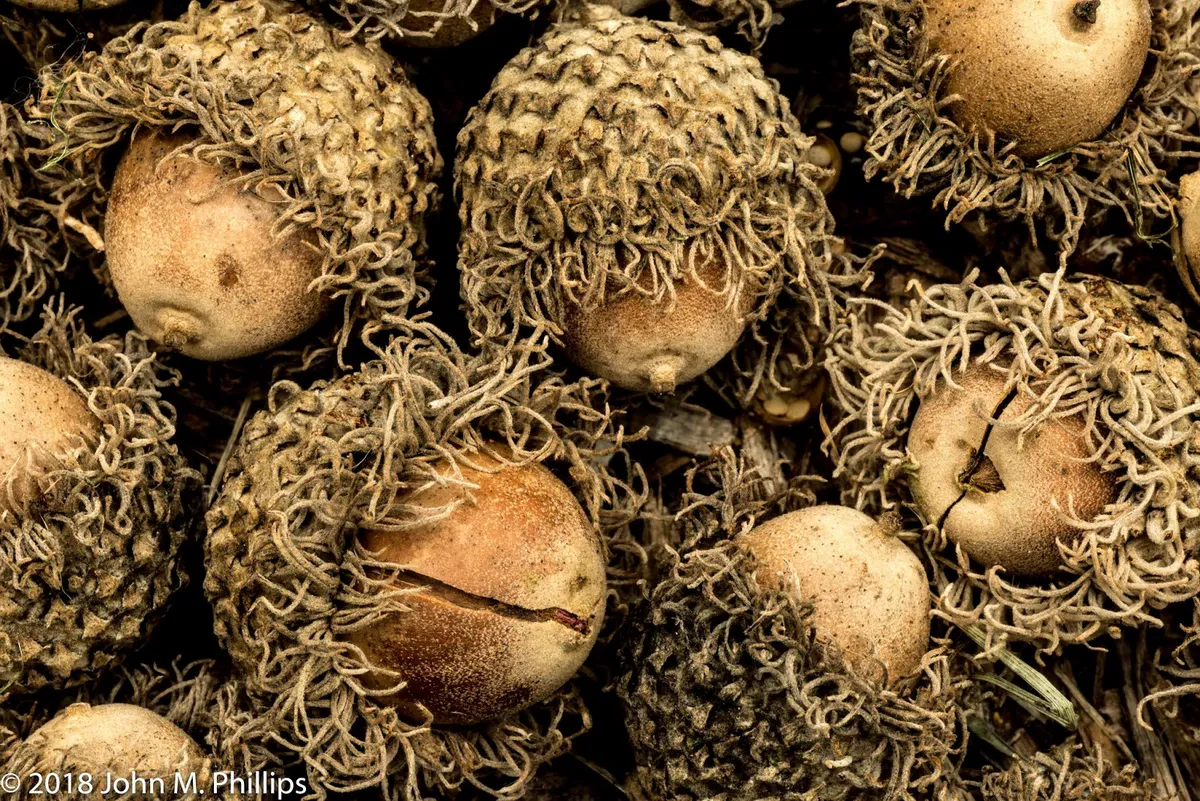
Image source: John M. Philips / skepticphoto.blogspot.com
7. Acorn Woodpeckers: The Oak’s Unwavering Devotees
In the world of birds, the Acorn Woodpecker stands out as the oak tree’s most fervent admirer. These birds exhibit an unparalleled dedication to acorns, which form a cornerstone of their diet and daily life. Beyond mere consumption, they go an extra mile — or perhaps, an extra hole — to ensure their beloved acorns are safe.
These woodpeckers meticulously carve out individual holes, often on the bark of trees or even wooden man-made structures, to store each acorn. It’s nature’s version of a custom-built vault, where every item has its own dedicated slot. Scientifically, this behavior showcases not just their affinity for oaks, but an evolutionary adaptation for survival. In certain habitats, these acorn granaries can house thousands of acorns, a testament to their industrious nature.
Drawing a parallel with human fandom might make one chuckle, but consider this: If the oak was a rockstar, the Acorn Woodpecker would be that superfan with every album, every poster, attending every concert. Their survival and prosperity, in many ways, is a duet sung with the oak tree.
8. Oaks and Their Formidable Corky Ridges
Ever noticed the rugged texture on certain oak twigs? These prominent, cork-like outgrowths are called “corky ridges” and are particularly prevalent in species like the pin oak (Quercus palustris). While they might look like nature’s equivalent of bodybuilder muscles, they have a functional role that’s crucial for the tree’s survival.
Research suggests these ridges offer a robust defense against external threats, from herbivores to certain fungal infections. Historical records and indigenous knowledge also point to these distinctive features as markers for certain oak varieties that were used for specific purposes, like shipbuilding. So, as you stroll past an oak showcasing its corky ridges, remember you’re witnessing an evolutionary marvel that’s been millions of years in the making.
9. The Sun-Kissed California Live Oak Tree
Amidst the vast oak family, the California live oak (Quercus agrifolia) stands out with its perpetual verdant charm. Unlike many of its deciduous cousins that shed leaves in winter, this oak has adapted to California’s Mediterranean climate by retaining its leaves all year. This evolutionary strategy offers a two-fold benefit: conserving water during the dry months and providing continuous shelter for wildlife.
Historical records indicate that Native American tribes in the region utilized the tree extensively, from its acorns as a food source to its bark for medicinal purposes. So, the next time you see a California live oak standing proudly, draped in green amidst a backdrop of bare winter trees, think of it as nature’s evergreen celebrity, flaunting its time-tested resilience and beauty.
10. Quenching the Thirst: The Resilient Water Oak Trees
Venture into the southeastern regions of the United States and you’re likely to encounter the robust water oak trees (Quercus nigra). Aptly named, these trees have a proclivity for water-rich environments, establishing themselves firmly in floodplains, riverbanks, and other moist areas.
Their preference isn’t just a mere coincidence. This species has evolved to not only survive but thrive in areas where many other trees might struggle. This adaptability has made them a pivotal part of wetland ecosystems, where they play a crucial role in soil stabilization and providing habitat for a range of species.
Scientific studies also point out their ability to grow at a relatively faster rate compared to other oak species. This rapid growth, potentially fueled by their watery surroundings, positions them as vital for reforestation efforts, especially in regions recovering from deforestation or natural disturbances. In the narrative of trees, the water oak emerges as a symbol of resilience, growth, and the wonders of nature’s adaptability.
11. The Bur Oak’s Acorns: Nature’s Pioneering Hydrologists
Journey to North America’s vast grasslands and forests, and you’ll likely encounter the towering bur oak (Quercus macrocarpa), renowned for its hefty acorns—some of the largest in the oak family, rivaling the size of golf balls or even small lemons. But beyond this spectacle lies a hidden functionality pivotal for ecosystem balance.
Historical accounts and botanical research suggest these acorns have been more than just an ample feast for local fauna. When they descend and nestle into the earth, their considerable weight and size fashion subtle indentations in the soil. These acorn-carved depressions subsequently play a surprising role in hydrology. Functioning as natural basins, they collect rainwater, mitigating surface runoff, promoting groundwater recharge, and ensuring the consistent hydration of local flora. This passive water management strategy underscores the intricate ways in which the bur oak acorns foster a symbiotic relationship with their environment. In essence, the bur oak’s acorns epitomize nature’s genius, melding form with multifaceted function.
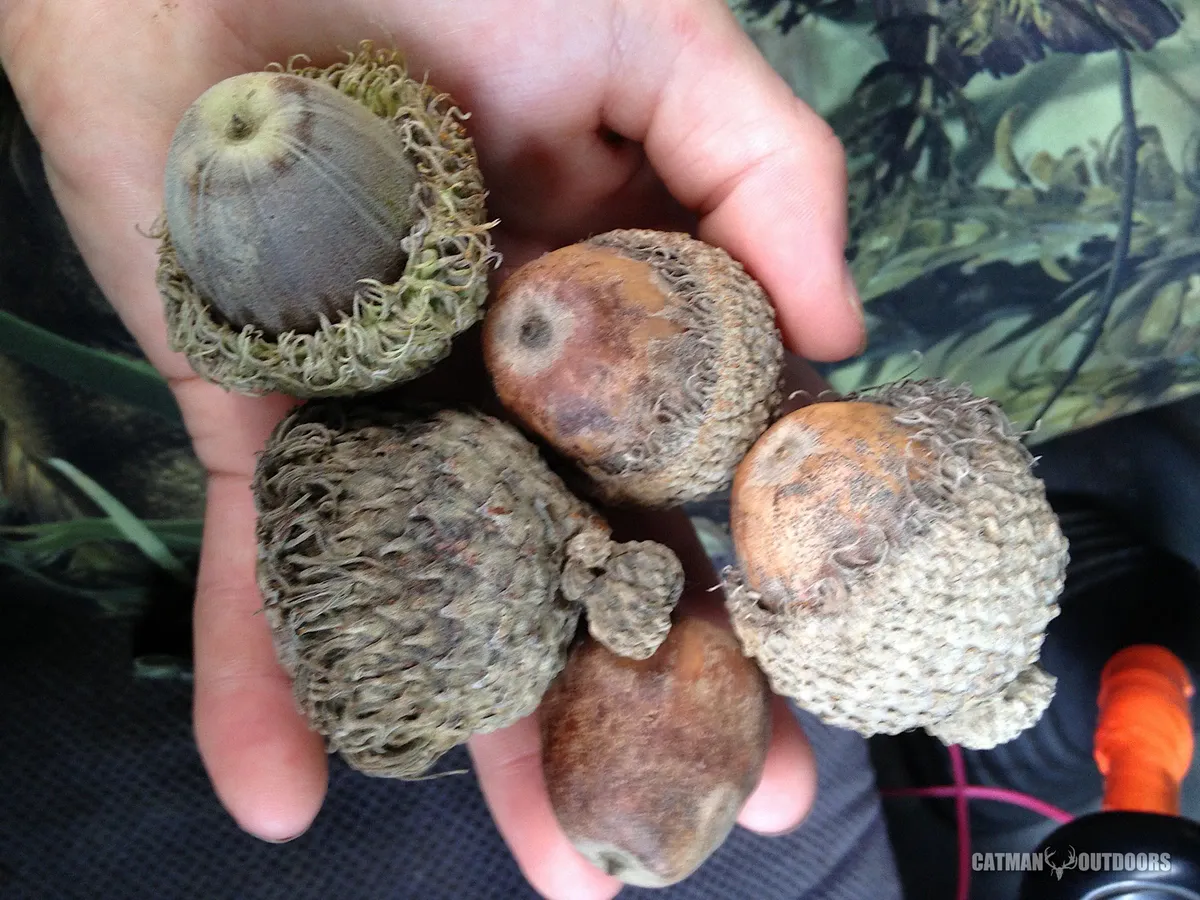
Image source: catmanoutdoors.com
12. The Urban Champion: Pin Oak Trees
The pin oak, with its roots deep in North American history, stands as a testament to nature’s adaptability. Favoured for its resilience to city pollution and compacted soils, this tree has been an urban mainstay since 19th-century landscaping designs. Its moniker, derived from the slender, pin-like branches, is more than aesthetic; recent studies suggest they enhance nutrient distribution.
As cities evolved, so did the pin oak, effortlessly merging the ancient with the contemporary. A walk among city streets often reveals this nature’s multitasker, proving that even in the busiest urban environments, deep-rooted traditions thrive.
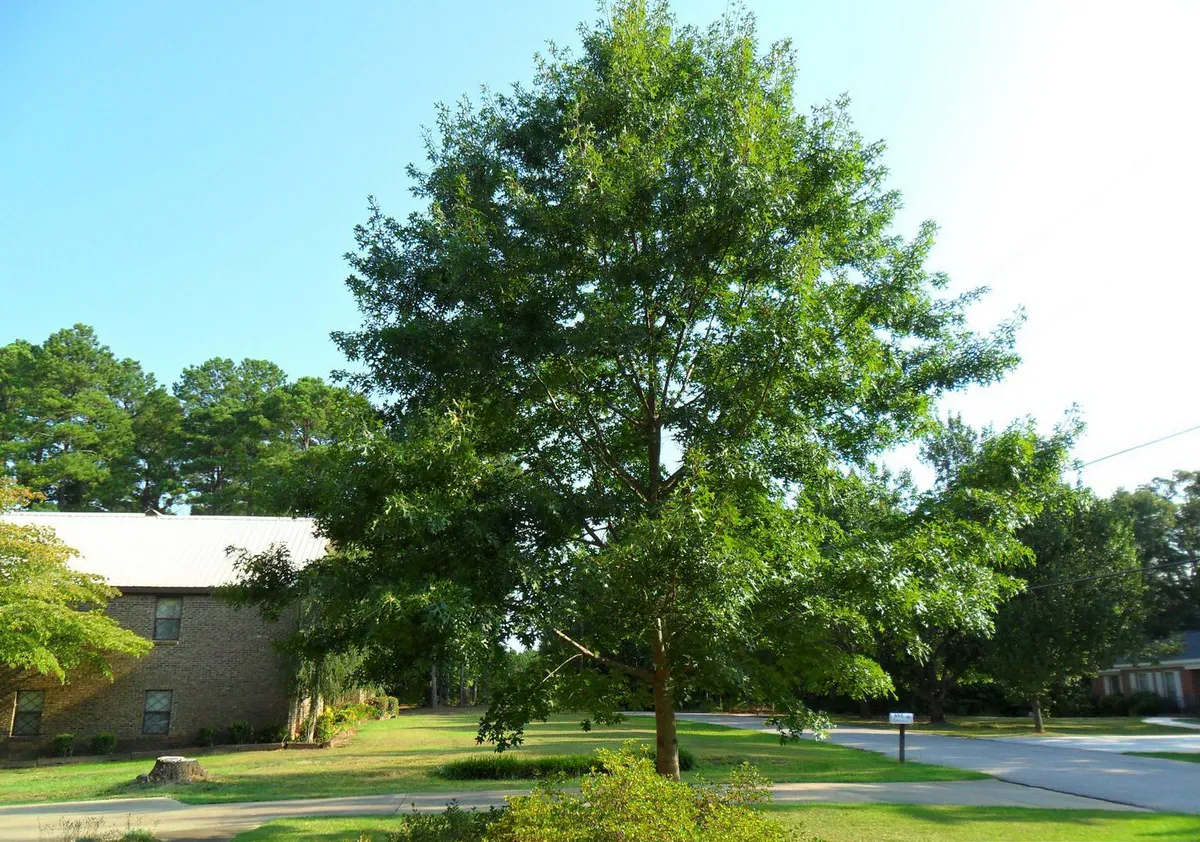
Image source: forestryimages.org
13. Coastal Guardian: The Coast Live Oak
The coast live oak, Quercus agrifolia, isn’t just California’s coastal gem by accident. Historically, these trees have flourished for thousands of years in the region’s unique Mediterranean climate, known for its warm, dry summers and mild, wet winters. But beyond its enviable location, it plays a pivotal role in coastal conservation.
Research indicates that its expansive root system has been instrumental in preventing soil erosion along California’s fragile coastline. Additionally, it’s a linchpin for biodiversity, offering refuge to countless endemic species. While humans often fantasize about beachside living, the coast live oak has been there for millennia, serving both as a protector and dweller of the Golden State’s iconic shores.
14. The Bountiful Legacy of Oaks: A Historical Acorn Deluge
Oak trees have been an emblem of generosity and abundance in ecosystems across the world for millennia. Historically, indigenous tribes like the Native Americans once relied heavily on these acorns as a food source, grinding them into meal or flour after elaborate processing. A single mature oak can astoundingly yield up to 2,200 pounds of acorns in a prolific year. To put this into perspective, that’s almost the weight of a 1965 Mini Cooper!
Beyond being a dietary staple for indigenous peoples, these abundant acorns are a lifeline for numerous wildlife species. Stand beneath an oak, and you’re essentially beneath a historic granary that has nourished generations of both humans and animals.

Image source: farmersalmanac.com
15. The Tan Oak’s Historic Tannery: Turning Bark into Gold
The Tan Oak Tree, despite its misleading name, isn’t an actual member of the oak family. Instead, it stands out for a unique reason: its bark is a treasure trove of tannin, a vital ingredient historically used in the leather tanning industry. Historical records show that Native Americans and early settlers recognized its value and used it extensively for processing hides.
With its rich tannin content, by the 19th century, the bark of the tan oak became a significant export product, especially during the California Gold Rush era, when durable leather goods were in high demand. While it bears oak-like leaves, earning its honorary membership in the oak club, its true legacy lies in transforming raw hides into precious leather commodities.
16. Oaks’ Historical Armor: From Cork Defenses to Gall Artistry
Oak trees have long stood as silent guardians of forests, armed with nature’s innovative defense mechanisms. Their outer bark, rich in cork, has served them well since ancient times. Historical texts suggest that people recognized the repellent properties of oak bark against pests, using it in various protective capacities. But when the cork isn’t deterrent enough, oaks have another trick up their sleeve.
They produce “galls” in response to certain insects, mainly gall wasps, laying eggs on them. Interestingly, in the Middle Ages, these galls became highly sought after as a primary ingredient in making iron gall ink, a staple in European writings for centuries. So, while the oak defends itself, it inadvertently offers up both protection and artistry, showcasing nature’s intertwining beauty and resilience.
17. The Lofty Heights of Black Oaks: Nature’s Skyscrapers
The ambitious black oak has long been a marvel of nature. Records suggest that black oaks can soar to heights exceeding 80 feet, a testament to their resilience and vitality. Their growth has been a topic of several ecological studies, which attribute such growth to their adaptability and efficient nutrient distribution.
Historically, these towering trees were crucial for indigenous tribes, with the height making them ideal lookout points in dense forests. Besides their stature, these oaks have dense canopies, hosting myriad creatures, becoming veritable high-rises in the animal kingdom. So, when you see a black oak, you’re looking at a living legacy of endurance.
18. The Bowthorpe Oak: A Millennia-Old Sentinel
The Bowthorpe Oak in Lincolnshire, UK, stands as a living testament to over a thousand years of history. Researchers and dendrologists, studying this ancient giant, believe it started growing during the early medieval period. Its sprawling branches have witnessed key events in history, from the Norman Conquest in 1066 to the signing of the Magna Carta in 1215.
Its boughs might have provided shelter during the Wars of the Roses, and its acorns fell as Shakespeare crafted his masterpieces. Beyond its historical backdrop, the Bowthorpe Oak serves as a research subject for understanding longevity and resilience in trees. Each ring in its trunk is a chapter in a long, unfolding story of endurance.
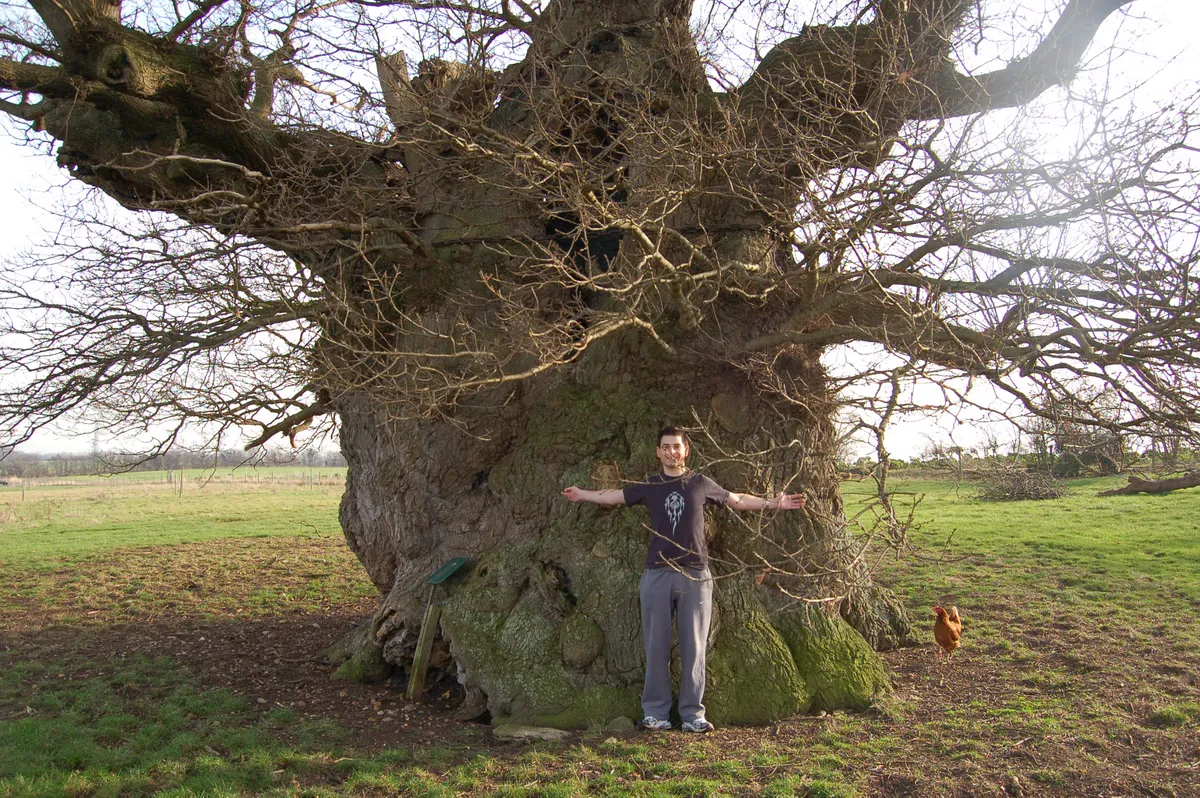
Image source: Wikimedia Commons
19. Acorns: Oak Trees’ Remarkable Legacy
Acorns, the seed of the mighty oak, have been more than just a symbol of potential. Archaeological findings reveal that, for centuries, acorns served as a staple food for ancient civilizations. Rich in protein and fat, they provided essential nutrients.
Scientifically, an acorn’s germination is influenced by factors such as soil pH and microbial activity. Moreover, a single oak tree can produce over 10,000 acorns annually, though only one in 10,000 acorns will mature into a full-grown tree.
Interestingly, according to research from the University of Oxford, the tannins in acorns can deter herbivores, ensuring survival for the next generation of oaks. So, when observing an acorn, you’re truly looking at millennia of evolutionary success in the palm of your hand.
20. Cork Oaks: The Guardians of Time-Honored Traditions
The cork oak tree, predominantly found in the Mediterranean regions of Europe and Africa, is a testament to nature’s versatility. Historical records from the Roman Empire hint at the use of cork for various purposes, showcasing its enduring legacy.
Modern research reveals that these trees can be stripped of their bark every 9 to 12 years without harming the tree, making it a sustainable resource. The unique cellular structure of cork makes it an ideal stopper for wine bottles, preserving the flavor and integrity of the wine. UNESCO even recognizes the cultural significance of cork oak landscapes in Portugal.
So, as you pop open that wine bottle, you’re not just enjoying a drink but partaking in a historical tradition, safeguarded by the remarkable cork oak.
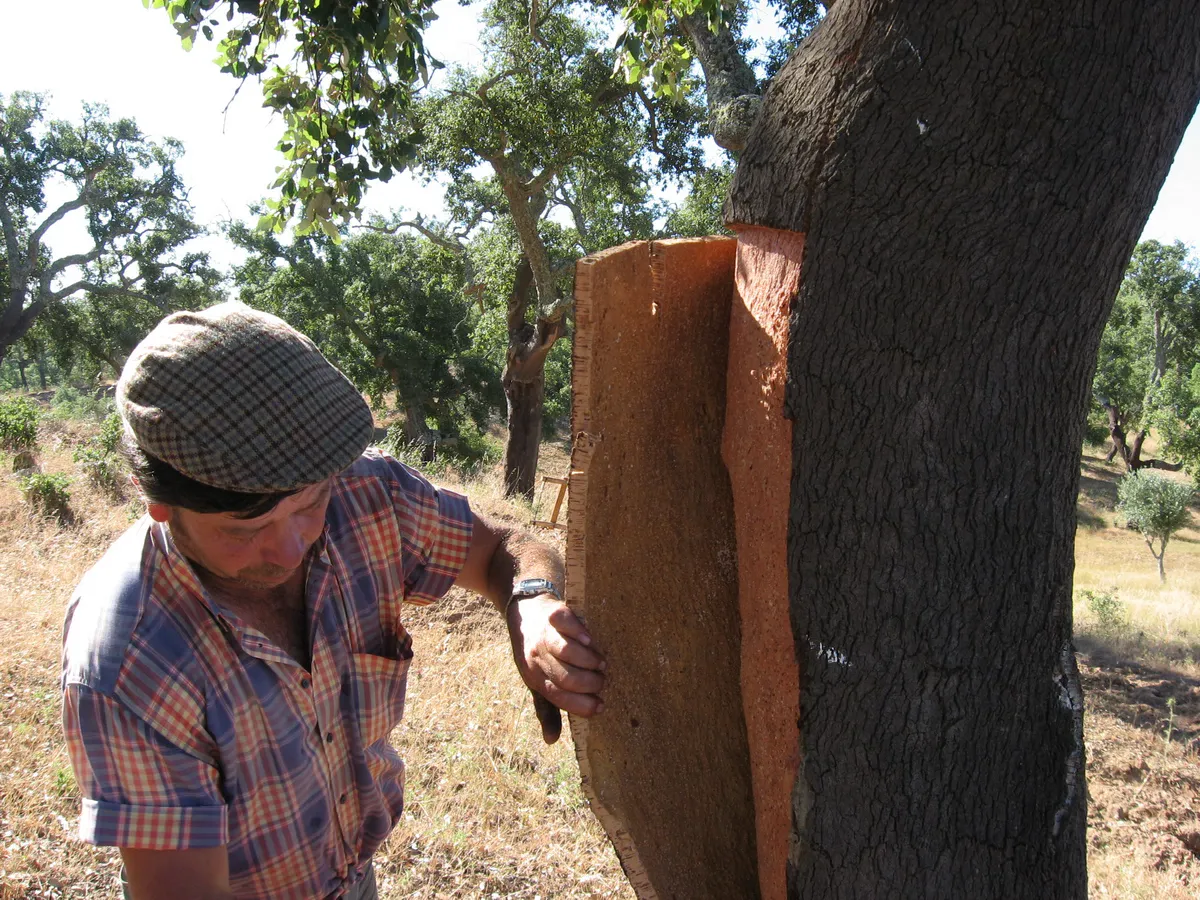
Image source: Wikimedia Commons
21. The Quercus Garryana: Hollywood’s Green Star!
Ever heard of a tree named after a British naval officer? Meet the Quercus garryana, dubbed the Garry oak in honor of Nicholas Garry, deputy governor of the Hudson’s Bay Company in the 19th century. Found along the western coasts of North America, this oak is an emblem of resilience.
In the tree world, this oak is a true method actor. While many oaks love the water, the Garry oak thrives in drier habitats, from well-drained valleys to craggy slopes. Historical records indicate that indigenous tribes revered the Garry oak, using its acorns as a food source and its bark for medicinal purposes.
Sporting a rough, deeply furrowed bark and glossy leaves, the Garry oak has a unique flair. It’s like the Meryl Streep of oaks – timeless, versatile, and with a story rooted deep in history. In the limelight or in the wild, it effortlessly commands attention. Cheers to the Garry oak, nature’s true A-lister!
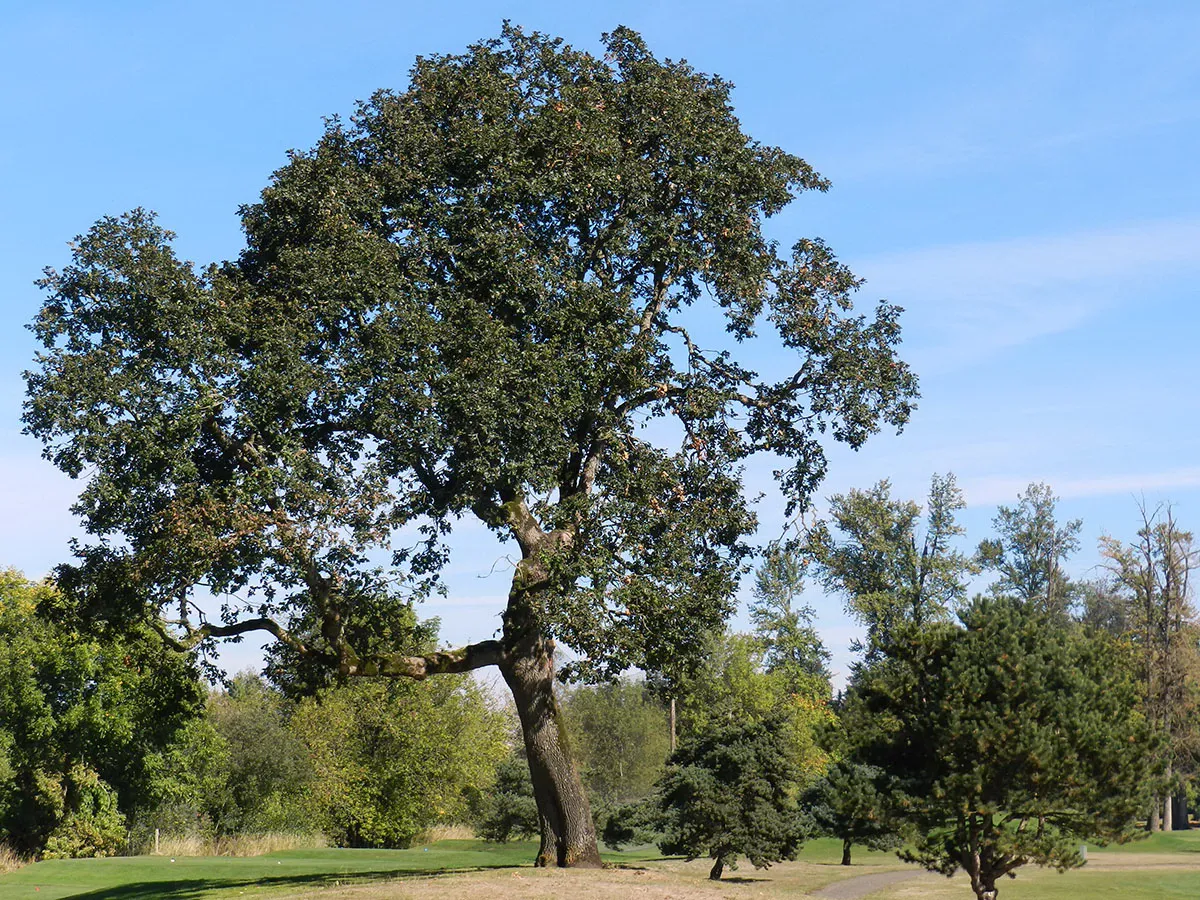
Image source: oregonstate.edu
22. The Resilient Tan Oak Tree: Nature’s Phoenix with a Historical Resumé
The tan oak tree showcases a magnificent lesson in resilience, echoing nature’s perseverance. Historically, indigenous tribes of North America utilized tan oaks, especially their acorns, as a primary food source.
Studies show that after severe forest fires, these trees are among the first to regrow, drawing strength from their deep-rooted history. Their post-fire resurgence is akin to the rebuilding of cities after historical events like wars or natural disasters. Truly, if trees had history books, tan oaks would be their legendary heroes.
23. Oak Trees: Coming of Age at Twenty with Historical Significance
Oak trees have a tradition that dates back millennia. While many plants reproduce early in their life cycle, oaks make us wait, often taking two decades before bearing their first acorn.
Historical records suggest that indigenous tribes celebrated such milestones, considering the oak’s first acorn drop a significant event. The tribes utilized these acorns as food, grinding them into nutritious flour. So, when an oak tree turns twenty, it’s not just a botanical event; it’s a continuation of a tradition that dates back thousands of years.
24. The Oak’s Annual Chronicles: A Timeline of Natural Events
Oaks have been Earth’s scribes for ages. Inside each oak, growth rings depict tales from as far back as the tree’s sprouting. For instance, some oaks in Europe have witnessed events like the signing of the Magna Carta in 1215 or the beginning of the Renaissance in the 14th century.
An oak’s rings have provided researchers with invaluable data about historical climatic conditions, helping to unlock weather patterns and even events like volcanic eruptions. To leaf through an oak’s rings is akin to browsing the pages of a natural history encyclopedia.
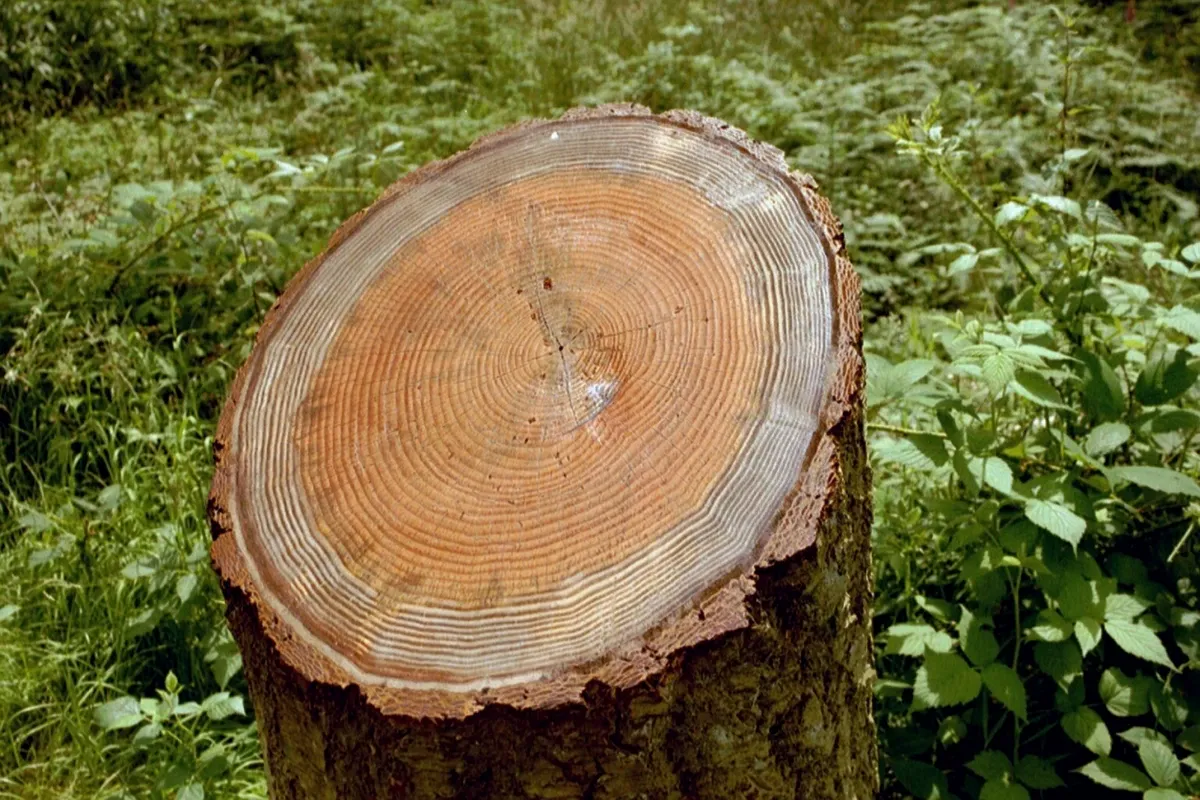
Image source: mast-producing-trees.org
25. The Royal Oak: From Monarchical Refuge to National Emblem
The Royal Oak isn’t just about arboreal beauty; it’s a symbol steeped in English history. In 1651, after the pivotal Battle of Worcester, King Charles II narrowly escaped capture by the Parliamentarian forces, taking shelter within the hollow of an oak tree. This strategic hideaway wasn’t just an act of survival—it was an emblem of resilience against adversity.
To commemorate this event, “The Royal Oak” became a popular name for pubs throughout Britain. The legacy of this tree transcends foliage; it’s intertwined with Britain’s national narrative, showcasing how nature and history often cross paths.
26. Oak and Honeydew Honey: Nature’s Exclusive Gourmet Concoction
While oak trees might be renowned for their towering presence and historical significance, there’s a subtler story they’re part of—a culinary delight. Aphids, drawn to the oak’s verdant canopy, produce honeydew, a sugary secretion. Bees, in their ever-efficient manner, collect this honeydew, crafting an oak-infused honey variant.
This isn’t your regular honey. It offers a unique, earthy taste—a signature flavor that’s a testament to the oak’s influence in nature’s pantry. This intricate dance between oaks, aphids, and bees adds a gourmet touch to our breakfast spreads.
27. Angel Oak of South Carolina: The Centuries-Old Shade Maestro
When speaking of trees that command respect, the Angel Oak stands (or rather spreads) apart. Located in South Carolina, this tree’s canopy stretches an astonishing 17,200 square feet, making it a natural wonder in its own right.
Historical records suggest that the Angel Oak has been standing tall for nearly 500 years. It’s not just a tree; it’s a monumental testament to time, nature, and resilience. Beneath its vast shade, generations have sought refuge, children have played, and countless stories have unfolded. It’s more than timber and leaves; it’s a living chapter of American history.
28. Moon Trees: The Celestial Sojourn of Oak Seeds
The cosmic expanse might seem beyond the realm of Earthly flora, but for some oak seeds, the stars were within reach. In the Apollo 14 mission of 1971, Stuart Roosa, a former U.S. Forest Service smoke jumper and the mission’s command module pilot, carried hundreds of tree seeds, including oaks, into space. They circled the moon and experienced zero gravity. On returning to Earth, despite the challenges of a space journey, many of these seeds germinated and grew, becoming the now-famous “Moon Trees.”
These trees, scattered across the United States and the world, are more than just plants. They symbolize the fusion of terrestrial life and space exploration. So, the next time you encounter an oak, ponder this: its kin once touched the stars, bridging the vastness between our blue planet and the infinite beyond.
29. Acorns: Nature’s Miracle Packets Bursting with Potential
The old adage, “mighty oaks from little acorns grow,” encapsulates nature’s wondrous capability. But what’s behind this transformation? It’s a tale of science, resilience, and evolution. Each acorn is a marvel of biological engineering, a miniature kit packed with carbohydrates, proteins, and fats. It has everything required to kickstart the life of a new tree.
In the right conditions, with optimal sunlight, nurturing soil, and moisture, this tiny seed embarks on a growth journey that can span centuries. Over time, what once was a small seed becomes an ecological giant, offering shelter to various fauna and playing a crucial role in forest ecosystems. This metamorphosis from a tiny acorn to a majestic oak serves as a metaphor for potential realized and the incredible patience of nature.
30. Quercus Chronicles: Navigating the Vast Oak Family
Dive into the realm of oaks, and you’ll find a captivating taxonomy maze. While “oak” might sound simple, the Quercus genus is anything but. Housing over 500 distinct species, each with its own unique set of characteristics, habitats, and adaptations, the oak family is a testament to nature’s diversity. From the Quercus virginiana of the American South to the Quercus ilex of the Mediterranean, each oak species has evolved in harmony with its environment.
This vast array of species is a result of millions of years of evolution, with each oak adapting to specific climates, altitudes, and ecological pressures. If there were an annual Quercus convention, it would be a vibrant gathering of species, each with its unique tales of survival and adaptation. So, the next time you admire an oak, know that it represents just one branch of a vast, intricate, and diverse family tree that spans continents and ages.
FAQ
What are 10 interesting facts about oak trees?
- Oak trees can live for hundreds of years, with some reaching over a thousand years old.
- There are over 500 species of oak worldwide.
- Oak trees don’t produce acorns until they’re about 20 years old.
- The bark of the cork oak is used to produce wine stoppers.
- They are deciduous or evergreen, meaning they can either shed or retain their leaves throughout the year.
- Oaks provide habitat and food for various wildlife.
- The Angel Oak in South Carolina is estimated to be around 400-500 years old.
- Oaks are found on all continents except Antarctica.
- The name “oak” is derived from an old English word “āc.”
- They play a crucial role in folklore and are considered sacred in many cultures.
What is unique about an oak tree?
Oak trees have a diverse range of species, each with unique characteristics, but their long lifespan, ability to thrive in various climates, and their acorn production make them stand out in the tree kingdom.
What does an oak tree symbolize?
Oak trees symbolize strength, wisdom, endurance, and longevity in various cultures due to their robust nature and long lifespans.
What are some facts about oak leaves?
Oak leaves are lobed and come in various shapes and sizes, depending on the species. They change colors in fall and are a staple diet for many caterpillar species. The leaves also contain tannin, which has been used in traditional leather tanning.
What are some interesting facts about the white oak tree?
White oak trees (Quercus alba) can live up to 600 years. They have a broad, rounded crown and produce acorns that mature in one season. The bark is light gray, and the wood is durable, making it popular for construction and furniture.
Why are oak trees sacred?
Oak trees are sacred in many cultures due to their strength, longevity, and the belief that they are a connection between the heavens and the earth. Druids, in particular, considered oaks sacred and performed rituals in oak groves.
Why is an oak tree strong?
The oak’s root system is extensive, providing a stable foundation. Its wood has a high density and is packed with tannins, making it resistant to fungal and insect attacks, contributing to its strength.
Why is oak wood so popular?
Oak wood is popular due to its durability, strength, and aesthetic appeal. It’s versatile and has been used in everything from shipbuilding to furniture making because of its resistance to decay.
How rare are oak trees?
Oak trees are not rare and are widely distributed across the Northern Hemisphere. However, some specific species or old specimens might be rare due to factors like deforestation and urbanization.
What is a quote about an oak tree?
“The creation of a thousand forests is in one acorn.” – Ralph Waldo Emerson.


